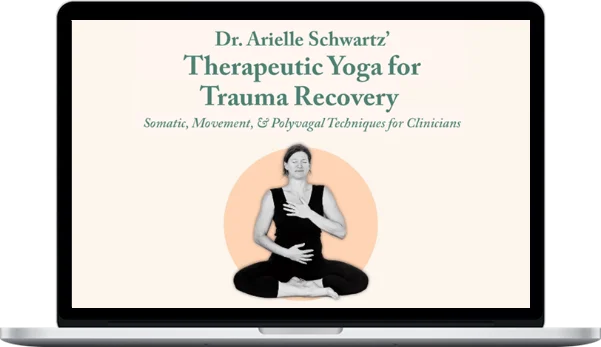Dr. Arielle Schwartz’ Therapeutic Yoga For Trauma Recovery: Somatic, Movement, & Polyvagal Techniques for Clinicians
$199.99 $90.00
Total Sold: 1
»Instant Delivery
Description
Dr. Arielle Schwartz’ Therapeutic Yoga For Trauma Recovery: Somatic, Movement, & Polyvagal Techniques for Clinicians
Expand your practice and empower deep healing with the only trauma-informed yoga designed for mental health professionals.
Introducing the most premier yoga for mental health professionals available today.
This all-new course in trauma-informed yoga for mental health clinicians gives you everything you need to confidently work with a traumatized nervous system—without becoming a yoga teacher overnight or sacrificing your clinical foundation.
Developed with renowned traumatologist, bestselling author, and registered yoga teacher Dr. Arielle Schwartz, this training blends Polyvagal Theory, somatic psychology, and trauma-informed yoga into a practical, step-by-step approach.
No fluff. No guesswork. No jargon. Just a clear path to help clients feel safe in their bodies and regulated in their nervous systems—using tools you can apply right away.
Inside this yoga for clinicians course, you’ll learn how to:
- Confidently introduce trauma-informed yoga therapy into sessions—with clear guidance on informed consent, boundaries, and trauma sensitivity
- Increase clients’ body awareness and emotional regulation with no-touch somatic tools
- Support nervous system balance with polyvagal-informed breathing, movement and postures
- Structure start-to-finish therapeutic yoga sessions that target each client’s unique goals
- Integrate techniques from parts work, EMDR, and more
Whether you’ve been practicing yoga for years or you’re just thinking about expanding your skillset in this area…
Program Information
Objectives
- Define trauma and its impact on the mind and body.
- Explain the role of nervous system dysregulation in trauma.
- Describe the core components of therapeutic yoga for trauma.
- Describe the eight limbs of yoga and their application to trauma recovery.
- Create effective treatment plans based in somatic therapy and yoga for clients with trauma histories.
- Explain the principles of somatic psychology and its integration with trauma treatment.
- Facilitate intention setting, yoga practices, breathwork somatic body movements and more in therapy sessions.
- Describe the functions of the sympathetic and parasympathetic nervous systems as it relates to trauma and yoga.
- Understand the role of bilateral movements in support brain integration for trauma recovery and embodiment.
- Recognize the connection between physical posture, emotions, and mental health.
- Identify and address cultural, LGBTQ+, age, and disability considerations in therapeutic yoga.
- Establish appropriate boundaries, including physical touch, in somatic and yoga therapy settings.
- Develop appropriate documentation and note-taking practices for therapeutic yoga sessions.
- Define the role of the facilitator in therapeutic yoga sessions.
- Develop effective psychoeducation strategies for clients regarding body-based therapies.
- Understand the impact of attachment wounds and relational betrayals on trauma recovery.
- Explain the role of neuroplasticity in healing from trauma.
- Outline the key steps in structuring an initial somatic yoga therapy session.
Outline
Module 1: Trauma & The Body
- Defining Trauma, types of, and comorbidities
- Impact of Trauma on Mind and Body: Physical, Mental, Emotional
- Integrate somatic psychology principles within yoga for trauma recovery
- Understanding top down and bottom-up interventions
- Root causes of symptoms: Nervous System Dysregulation
- A “Resilience Informed” approach to care
- The relationship between pre-verbal memories and somatic symptoms
- What to know about overarousal and under arousal
- The 3 Sensory systems and why they matter
- Yoga as a tool for sensory integration and dual awareness
- Peter Levine’s on “Thwarted Instincts” and Repatterning
- Polyvagal theory and interpersonal neurobiology
- Stuckness in sympathetic or parasympathetic nervous system states
- Act & Third wave CBT and mindfulness of the present moment
- Risks and limitations
- Reflection and Practice: What are factors of resilience for you?
- Key experiential exercises: What awakens you, Playing with Stillness
- Demonstration: Prayer hands, grounding blanket
Module 2: The Integration of Clinical Trauma Recovery Models & Yoga
- Assessing readiness for trauma processing
- Tuning into the clients’ pacing for processing
- Trauma work is grief work
- Core components of Therapeutic Yoga for Trauma
- The 8-limbs of the yogic tree through a trauma-informed lens
- Science, Soma, and Soul: The core components of Embodied Spirituality
- Spirituality within psychotherapy as differentiated from religion
- Watts Connectedness Scale
- Symptoms as a messenger: The shift from “illness” to “wellness”
- Exercise: Integrating Values into Daily Life
Module 3: Somatic Therapy, Polyvagal Theory and Interpersonal Biology for Trauma Treatment
- Neuroanatomy of the mind-body connection
- The functions of the sympathetic and parasympathetic nervous system
- Core Components of Polyvagal Theory
- The window of tolerance
- Neuroception of psychological safety scale (NPSS) assessment
- Co-Regulation as a Shared window of tolerance
- Boundaries and Proximity Awareness
- 4 Key strategies for Repairing Therapeutic Ruptures
- Learn compassion-based practices to work through barriers to wellbeing
- Creating greater therapist self-awareness and self-knowledge
- Practice: Co-Regulation, 4 Embodied Self-Compassion practices
- Exercise: 5-point check-in for starting session, Shy Blanket
- Demonstration: Proximity Awareness
Module 4: Rewiring for Resilience: Neuroplasticity & Natural Vagus Nerve Stimulation in Trauma Recovery
- Neuroplasticity and the ability to grow in adulthood
- Memories as neural networks
- Stress-induced and exercise induced neuroplasticity
- Natural ways to stimulate the vagus nerve
- Understand Vagal Tone and Vagal Efficiency
- Heart rate variability and breathwork
- Restoring safety and stability to the nervous system with Natural Vagus Nerve Stimulation
- Practice: Gratitude, Balanced Breathing, Humming
Module 5: Integrating Mindful Movement and Stillness in Trauma-Informed Yoga
- The connection between physical posture and the nervous system
- Explore the science of fascia and myofascial release
- Recognize the role of bilateral movements to support brain integration
- Keys to EMDR and exploring “eye yoga”
- Restorative practices and Trauma Sensitive Mindfulness
- Dual awareness in Trauma Recovery and the yoga practice
- Creating side-body awareness
- Default mode networking, rumination, and hyperviligence
- Risks, limitations and considerations
- Exercise: Grounding while standing, Grounding while seated, Half Salamander
- Practice: Wall Press & Boundary Awareness, Reflex Integration for nervous system health, Settling into stillness, Restorative Stillness
Module 6: Start-to-Finish Structuring of Trauma Informed Yoga Sessions
- Inclusivity and Accessibility considerations: ability, body image, chronic pain & more
- Elements of a trauma informed-yoga session
- What to do when a client feels overwhelmed
- Verbal Assists: Invitational language vs. Commands
- Help clients find their growth edge while maintaining safety
- Finding the Golden Nugget in each session
- Internal Family Systems on the Yoga Mat to navigate ambivalence and inner polarities
- Integration of evidence-based modalities: TF-CBT, Prolonged Exposure, EMDR, Narrative Therapy & more
- Exercise: Build Affect and Sensation Tolerance, Working with Somatic Tension, Mindful Movement
- Practice: Finding your voice
Module 7: Practical Considerations
- Psychoeducation and explaining body-based work to clients
- Informed Consent items to know
- Inviting special and relational awareness to clients
- Boundaries, especially with physical touch
- Setting up your office
- Telehealth considerations and adaptations
- Keys to documentation and note taking
- Scope of practice considerations
- Clarifying treatment goals and objectives
- Confidentiality considerations
Module 8: In-Session Demonstrations of Trauma-Informed Yoga Sessions
Session I: The Growth Edge
- Understand client history, strengths and resiliency factors, focus of session, interventions used: somatic therapy, body change, Co-regulation strategies, parts work, cognitive techniques
Session II: Somatic Yoga & Parts Work (online session)
- Understand client history, strengths and resiliency factors, focus of session, interventions used: somatic therapy, embodied sense of safety, Co-regulation strategies, parts work, cognitive techniques
Session III: Integrative Approach to Trauma Reprocessing
- Understand client history, strengths and resiliency factors, focus of session, interventions used: somatic therapy, body change, Co-regulation strategies, parts work, cognitive techniques, resource development, EMDR
Therapist Cleansing
- A short practice to let go of clients after each session, based in parts work, somatic resonance, lifeforce energy and countertransference.
Target Audience
- Counselors
- Social Workers
- Psychiatrists
- Psychologists
- Psychotherapists
- Case Managers
- Addiction Counselors
- Therapists
- Marriage & Family Therapists
- Psych Nurses
- Other Mental Health Professionals
- Physical Therapists and Other Rehab Professionals
About Arielle Schwartz
World-Leading Traumatologist. Yogi. Bestselling Author. Practicing Psychologist.
When Dr. Schwartz teaches – therapists listen, because her tools not only work – they’ve redefined what therapists are doing in their sessions.
Dr. Schwartz’s unique and integrative expertise has set her apart in the field of psychotherapy. She founded the Center for Resilience Informed Therapy and developed Resilience Informed Therapy, an integrative model of care facilitating recovery from childhood trauma, PTSD, complex-PTSD and dissociation. She’s a Certified Complex Trauma Treatment Professional Level II, an EMDR consultant, somatic psychology expert, trained in mindfulness-based therapies and relational psychotherapy.
Beyond this, Dr. Schwartz is a renowned Polyvagal Theory expert. Even Dr. Stephen Porges has praised Arielle’s work, which focuses on addressing imbalances within the autonomic nervous system that underlie most mental and physical health conditions.
A Registered Yoga Teacher, Dr. Schwartz has been teaching therapeutic yoga since 2008 and is the author of Therapeutic Yoga for Trauma Recovery, one of the most widely referenced guides to applied Polyvagal Theory in trauma recovery.
A sought-after international speaker, Dr. Schwartz’ work can be found at Psychotherapy Networker, Art of Living, Omega Institute, and many other places.
More courses from the same author: Arielle Schwartz
Delivery Policy
When will I receive my course?
You will receive a link to download your course immediately or within 1 to 21 days. It depends on the product you buy, so please read the short description of the product carefully before making a purchase.
How is my course delivered?
We share courses through Google Drive, so once your order is complete, you'll receive an invitation to view the course in your email.
To avoid any delay in delivery, please provide a Google mail and enter your email address correctly in the Checkout Page.
In case you submit a wrong email address, please contact us to resend the course to the correct email.
How do I check status of my order?
Please log in to HealthcareCourse account then go to Order Page. You will find all your orders includes number, date, status and total price.
If the status is Processing: Your course is being uploaded. Please be patient and wait for us to complete your order. If your order has multiple courses and one of them has not been updated with the download link, the status of the order is also Processing.
If the status is Completed: Your course is ready for immediate download. Click "VIEW" to view details and download the course.
Where can I find my course?
Once your order is complete, a link to download the course will automatically be sent to your email.
You can also get the download link by logging into your HealthcareCourse account then going to Downloads Page.
Related products
Total sold: 2










